
Mayflies are aquatic insects belonging to the order Ephemeroptera. This order is part of an ancient group of insects termed the Palaeoptera, which also contains dragonflies and damselflies. Over 3,000 species of mayfly are known worldwide, grouped into over 400 genera in 42 families.

The Hare's Ear or Gold Ribbed Hare’s Ear is a traditional artificial fly imitating an aquatic insect larva (nymph) used in fly fishing.

Baetidae is a family of mayflies with about 1000 described species in 110 genera distributed worldwide. These are among the smallest of mayflies, adults rarely exceeding 10 mm in length excluding the two long slender tails and sometimes much smaller, and members of the family are often referred to as small mayflies or small minnow mayflies. Most species have long oval forewings with very few cross veins but the hindwings are usually very small or even absent. The males often have very large eyes, shaped like turrets above the head.
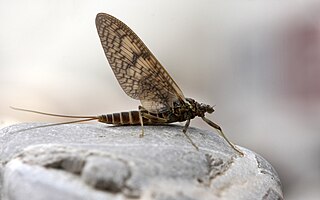
The Heptageniidae are a family of mayflies with over 500 described species mainly distributed in the Holarctic, Oriental, and Afrotropical regions, and also present in the Central American Tropics and extreme northern South America. These are generally rather small mayflies with three long tails. The wings are usually clear with prominent venation although species with variegated wings are known. As in most mayflies, the males have large compound eyes, but not divided into upper and lower parts.
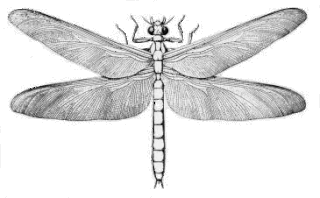
The Odonatoptera are a superorder of ancient winged insects, placed in the Palaeoptera which probably form a paraphyletic group however. The dragonflies and damselflies are the only living members of this group, which was far more diverse in the late Paleozoic and contained gigantic species, including the griffinflies of the order Protodonata. This lineage dates back at least to the Bashkirian, not quite 320 million years ago.
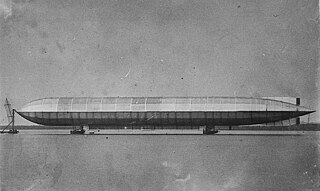
His Majesty's Airship No. 1 was designed and built by Vickers, Sons and Maxim at their works in Barrow-in-Furness, Lancashire, England, as an aerial scout airship for the Royal Navy. It was the first British rigid airship to be built, and was constructed in a direct attempt to compete with the German airship programme. Often referred to as "Mayfly", a nickname given to it by the lower deck, in public records it is designated ‘HMA Hermione’ because the naval contingent at Barrow were attached to HMS Hermione, a cruiser moored locally preparing to act as its tender.

Baetis is a genus of mayflies of the family Baetidae, known as the blue-winged olive to anglers. There are at least 150 described species in Baetis. They are distributed worldwide, with the most variety in North America and northern Europe.

Coxoplectoptera or "chimera wings" is an extinct order of winged insects containing one family, Mickoleitiidae. Coxoplectopterans are closely related to the mayflies.
Leptohyphidae is a family of mayflies with some 140 described species in 12 genera.

The Holy Family with the Dragonfly, also known as The Holy Family with the Mayfly, The Holy Family with the Locust, and The Holy Family with the Butterfly is an engraving by the German artist Albrecht Dürer (1471–1528) from approximately 1495. It is quite small but full of intricate detail. A very popular image, copied by other printmakers within five years of creation, it is found in most major print room collections, including the Indianapolis Museum of Art and the UK Royal Collection.

Pannota is a suborder of mayflies. One of the differences between this suborder and its sister group Schistonota concerns the degree of fusion of the wing pads in the final-stage nymph; in Schistonota, the degree of fusion along the mesothorax is more than half the fore-wing length while in Pannota the degree of fusion is less than half that length. Other differences between the two groups include the morphology of the gills and also behavioural differences. Schistonota nymphs are mostly active swimmers, burrowers and sprawlers, while Pannota nymphs are more passive, slow-moving crawlers.

Caenoidea is a superfamily of mayflies in the suborder Pannota. Members of this superfamily can be distinguished from those of Ephemerelloidea by the fact that the gills of the nymphs are filamentous.
Behningiidae is a family of mayflies. It is a primitive family; the nymphs burrow in the sediment but lack tusks on their mandibles, and the forelegs are not modified for burrowing. The gills are ventral, and the ones on the first abdominal segment are single and are longer than the gills on the other segments. The forelegs are palp-like and the other two pairs of legs are modified to protect the gills. The family is holarctic in distribution. The genus Dolania occurs in North America and the other two genera occur in northern Europe and Asia.
Neoephemeridae is a family of large squaregill mayflies in the order Ephemeroptera. There are at least 4 genera and about 17 described species in Neoephemeridae.
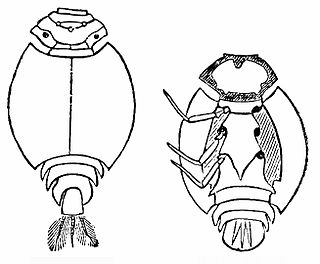
Prosopistomatidae is a family of mayflies in the order Ephemeroptera. There are at least 2 genera and 30 described species in Prosopistomatidae.
Tricorythidae is a family of mayflies in the order Ephemeroptera. There are about 6 genera and at least 40 described species in Tricorythidae.

Ephemera simulans is a species of mayfly. It is commonly found throughout the United States. The species is used for fly fishing.

Furcatergalia is a suborder of mayflies in the order Ephemeroptera. There are about 14 families and at least 1,700 described species in Furcatergalia.
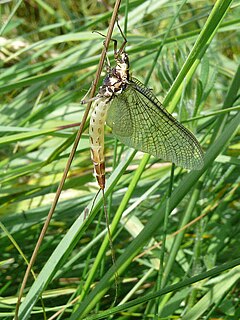
Polymitarcyidae is a family of pale burrower mayflies in the order Ephemeroptera. There are about 10 genera and more than 90 described species in Polymitarcyidae.
Arthropleidae is a family of flatheaded mayflies in the order Ephemeroptera. There are at least two genera, one of which is extinct, in Arthropleidae.














